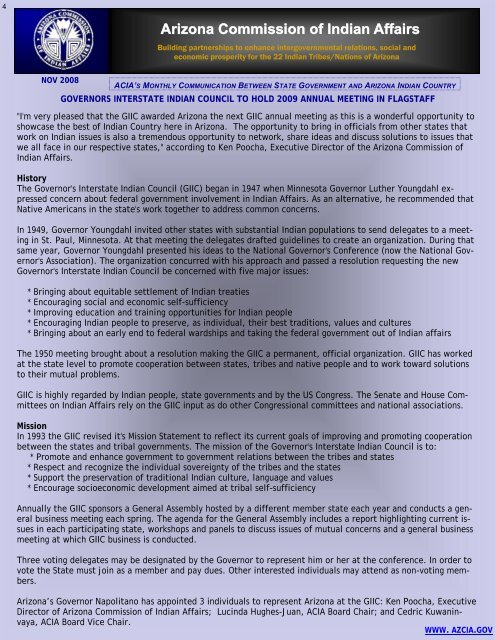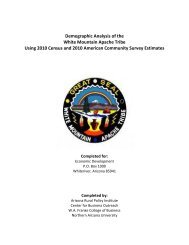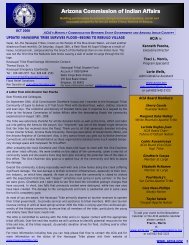November - Arizona Commission of Indian Affairs
November - Arizona Commission of Indian Affairs
November - Arizona Commission of Indian Affairs
Create successful ePaper yourself
Turn your PDF publications into a flip-book with our unique Google optimized e-Paper software.
4<br />
<strong>Arizona</strong> <strong>Commission</strong> <strong>of</strong> <strong>Indian</strong> <strong>Affairs</strong><br />
Building partnerships to enhance intergovernmental relations, social and<br />
economic prosperity for the 22 <strong>Indian</strong> Tribes/Nations <strong>of</strong> <strong>Arizona</strong><br />
NOV 2008<br />
ACIA’S MONTHLY COMMUNICATION BETWEEN STATE GOVERNMENT AND ARIZONA INDIAN COUNTRY<br />
GOVERNORS INTERSTATE INDIAN COUNCIL TO HOLD 2009 ANNUAL MEETING IN FLAGSTAFF<br />
"I'm very pleased that the GIIC awarded <strong>Arizona</strong> the next GIIC annual meeting as this is a wonderful opportunity to<br />
showcase the best <strong>of</strong> <strong>Indian</strong> Country here in <strong>Arizona</strong>. The opportunity to bring in <strong>of</strong>ficials from other states that<br />
work on <strong>Indian</strong> issues is also a tremendous opportunity to network, share ideas and discuss solutions to issues that<br />
we all face in our respective states," according to Ken Poocha, Executive Director <strong>of</strong> the <strong>Arizona</strong> <strong>Commission</strong> <strong>of</strong><br />
<strong>Indian</strong> <strong>Affairs</strong>.<br />
History<br />
The Governor's Interstate <strong>Indian</strong> Council (GIIC) began in 1947 when Minnesota Governor Luther Youngdahl expressed<br />
concern about federal government involvement in <strong>Indian</strong> <strong>Affairs</strong>. As an alternative, he recommended that<br />
Native Americans in the state's work together to address common concerns.<br />
In 1949, Governor Youngdahl invited other states with substantial <strong>Indian</strong> populations to send delegates to a meeting<br />
in St. Paul, Minnesota. At that meeting the delegates drafted guidelines to create an organization. During that<br />
same year, Governor Youngdahl presented his ideas to the National Governor's Conference (now the National Governor's<br />
Association). The organization concurred with his approach and passed a resolution requesting the new<br />
Governor's Interstate <strong>Indian</strong> Council be concerned with five major issues:<br />
* Bringing about equitable settlement <strong>of</strong> <strong>Indian</strong> treaties<br />
* Encouraging social and economic self-sufficiency<br />
* Improving education and training opportunities for <strong>Indian</strong> people<br />
* Encouraging <strong>Indian</strong> people to preserve, as individual, their best traditions, values and cultures<br />
* Bringing about an early end to federal wardships and taking the federal government out <strong>of</strong> <strong>Indian</strong> affairs<br />
The 1950 meeting brought about a resolution making the GIIC a permanent, <strong>of</strong>ficial organization. GIIC has worked<br />
at the state level to promote cooperation between states, tribes and native people and to work toward solutions<br />
to their mutual problems.<br />
GIIC is highly regarded by <strong>Indian</strong> people, state governments and by the US Congress. The Senate and House Committees<br />
on <strong>Indian</strong> <strong>Affairs</strong> rely on the GIIC input as do other Congressional committees and national associations.<br />
Mission<br />
In 1993 the GIIC revised it's Mission Statement to reflect its current goals <strong>of</strong> improving and promoting cooperation<br />
between the states and tribal governments. The mission <strong>of</strong> the Governor's Interstate <strong>Indian</strong> Council is to:<br />
* Promote and enhance government to government relations between the tribes and states<br />
* Respect and recognize the individual sovereignty <strong>of</strong> the tribes and the states<br />
* Support the preservation <strong>of</strong> traditional <strong>Indian</strong> culture, language and values<br />
* Encourage socioeconomic development aimed at tribal self-sufficiency<br />
Annually the GIIC sponsors a General Assembly hosted by a different member state each year and conducts a general<br />
business meeting each spring. The agenda for the General Assembly includes a report highlighting current issues<br />
in each participating state, workshops and panels to discuss issues <strong>of</strong> mutual concerns and a general business<br />
meeting at which GIIC business is conducted.<br />
Three voting delegates may be designated by the Governor to represent him or her at the conference. In order to<br />
vote the State must join as a member and pay dues. Other interested individuals may attend as non-voting members.<br />
<strong>Arizona</strong>’s Governor Napolitano has appointed 3 individuals to represent <strong>Arizona</strong> at the GIIC: Ken Poocha, Executive<br />
Director <strong>of</strong> <strong>Arizona</strong> <strong>Commission</strong> <strong>of</strong> <strong>Indian</strong> <strong>Affairs</strong>; Lucinda Hughes-Juan, ACIA Board Chair; and Cedric Kuwaninvaya,<br />
ACIA Board Vice Chair.<br />
WWW. AZCIA.GOV





